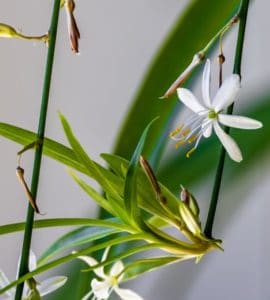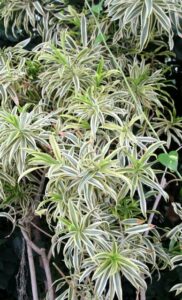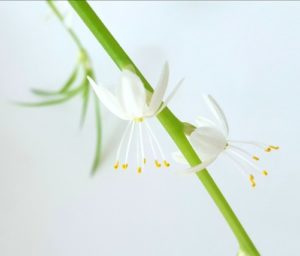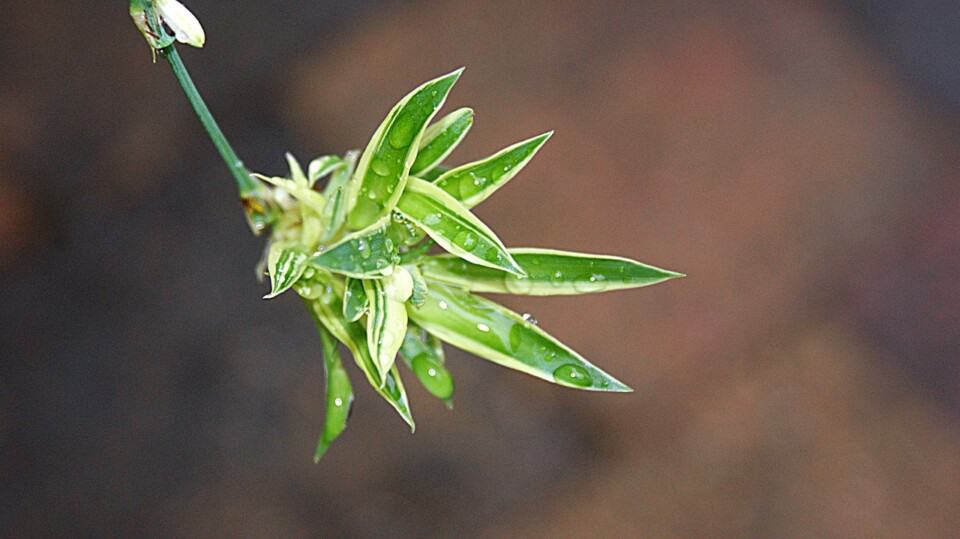Some links in the post are affiliate links and I get a commission from purchases made through some links found in the post.
You may know the spider plant as Chlorophytum comosum, or even a hen and chicks. Whichever name you know it as, we recognise if by the long slender green and white leaves and the small leaves which grow at the base of the leaves.
Not only do spider plants make great indoor and outdoor plants, but they are also easy to grow and propagate, require minimum maintenance, and look delightful when they are in a suitable place.
One thing about a spider plant that many people may not be aware of is that they have other benefits, apart from being beautiful.
The benefits of having a spider plant is that it is hard to kill, they purify and clean the indoor air, they are pet friendly, they aid in recover, they increase the humidity, they are great indoor decoration, they are edible and they absorb ozone.
Spider plants are native to tropical and southern Africa and can easily be propagated by simply planting the smaller plants in a potting mix or placing in a glass of water until roots form.
In the right conditions outside you can find spider plants which are quite large. As a houseplant inside you can expect your spider plant to reach about 50cm.
This does depend on the correct amount of light and the size of the pot. A pot bound spider plant will stay small.
There are several benefits of having a spider plant so let’s look at them.
Spider Plant Benefits
1) Very Hard to Kill
 This is an important point for novice gardeners and for anyone who feels they do not have that ‘green thumb.’
This is an important point for novice gardeners and for anyone who feels they do not have that ‘green thumb.’
Unlike most house plants, spider plants will not curl up and die if you have missed a watering session. They tolerate neglect moderately well and can do without water for a few days.
One of the things that they do not like is boggy soil so provided the potting mix drains well and the pot has a hole in, your spider plant will be just fine.
Spider plants can pretty much take care of themselves. They thrive well and adapt to most conditions. They don’t mind if you neglect them and can tolerate being both underwatered and overwatered.
Possibly one of the very few requirements your spider plant needs is bright indirect sunlight.
2) They Purify the Air
Spider plants are considered one of the best air purifying plants you can grow.
Not only does your common spider plant remove harmful chemicals for the air, but it also removes formaldehyde, a common household chemical which is frequently used in plastic items, pesticides, adhesives, curtains, leather goods and even in some clothing items.
This is a good point to remember if you or a family member suffers from any respiratory issues.
According to NASA the spider plant ranks in the top three household plants which remove formaldehyde, carbon monoxide, xylene, and toluene.
3) They are Pet Friendly
Spider plants are not listed on the Toxic plant list which is published by the ASPCA (American Society for the Prevention of Cruelty of Animals.)
However, as with any other plant it is advisable to keep animals from chewing on any part of the plant. If any part is going to harm your pet, it is likely to be the leaves, so it is important that animals do not eat your spider plant’s leaves.
The reason why you should keep your pets away from the spider plant is because the plant does contain a certain number of chemical compounds which are thought to be related to opium.
Eating these plants may cause an upset stomach, diarrhoea, and vomiting.
4) Aids in Recovery
Research has shown that when spider plants are placed in hospital rooms the recovery rate of patients tends to be faster than that of patients in rooms where there are no spider plants.
Additionally, patients need less medication, and do not suffer from heart rate or blood pressure problems. They also suffer less from depression and anxiety and tend to be released from hospital sooner.
5) They Increase the Humidity
You may know that your spider plant is classified as a perennial. It also has a high transpiration rate which means that it absorbs water through the roots. This water is then circulated through the leaves and stems.
Once the circulated water has reached the leaves it evaporates into the surrounding air and increases the humidity.
Increased humidity helps to lessen several airborne diseases. These include coughs, colds, sore throats, and flu symptoms.
Research has shown that keeping spider plants in the office environment or in the home will help keep these diseases away. Additionally, spider plants help to increase concentration and productivity.
6) Indoor Decoration
Spider plants can be placed either in pots or used in hanging baskets. They add a pleasant touch of green to the room and the spiderettes simply enhance the beauty of the plant.
The leaves of the spider plant can be either plain green or variegated, both of which make the plant look bold and beautiful, particularly in hanging baskets.
They are not very fast-growing plants so will not outgrow a container in a season. They will not need to be re-potted frequently. Because of this, they can easily be used to fill a small alcove where a little green livens up the area.
7) They are Edible
Both roots and leaves are edible to humans and can be used in salads. They have a mild flavour and can be added to several recipes such as stir-fries, egg dishes, and green smoothies.
8) Spider Plants Absorb Ozone
 Ozone occurs by a reaction between sunlight, water vapour, nitrogen oxide or sulphur oxide (known as the oxides of nitrogen.)
Ozone occurs by a reaction between sunlight, water vapour, nitrogen oxide or sulphur oxide (known as the oxides of nitrogen.)
This can be harmful to health if breathed in high amounts over a long time. Once ozone is absorbed into water droplets it becomes inert and is not harmful to humans.
Spider plants absorb ozone from the air because they breathe through their leaves. Additionally, the leaves are porous which allows for a gas exchange.
Spider Plant Spiritual Benefits
The symbol of the spider plant is fertility, and the plant is thought to reduce stress and keep the mind calm. Certainly, increasing oxygen will help us to inhale correctly.
The spider plant goes further by removing harmful irritants. It will also increase humidity which will help lower tiny dust particles which are particularly irritating for people with respiratory issues.
Spider plants which are placed indoors are symbolic of pure air and good mental and physical health.
Some beliefs say that a spider plant which is hung in a bedroom will symbolise fertility.
The ‘babies’ which grow from the spider plant are synonymous with fertility and new birth, so if you are planning on becoming pregnant you may consider hanging one in your bedroom. Ideally you should re-pot one of the babies from the plant.
Hanging the spider plant in the kitchen or placing it on the windowsill is said to bring abundance and prosperity.
To give the plant to another person who is moving away from home for the first time is to wish them luck and good fortune.
The spider plant is thought to remove the negative energy from a home and to promote Chi energy in the rooms.
Because spider plants absorb negativity they are believed to give energy to the home, and you should hang on or keep a pot plant in any area where you become stressed such as the study.
About Spiders and Webs
While many of us cringe at the thought of spiders in our homes, the spider plant is thought to bring energy.
When we visualise the spider plant as a web, we see that it can hold our ideas and dreams, keeping them safe until we are ready to use them.
The spider plant is symbolic of new creations and connections while also reminding us of our bonds with people and animals.
The web, which may appear to be a never-ending formation is to remind us of our existence, where we are always a part of the great design of life. While we may seem to be trapped in the web, we are in fact a part of life’s rich tapestry.
How to Propagate Spider Plants
These are among the easiest plants to propagate so there is no reason why you should not have several of them dotted around your home or even in your garden, if the conditions there are good.
- Wait for the ‘babies’ to appear and let them reach a size of a tennis ball.
- Snip off a ‘baby’ with clean scissors or shears.
- Place in a jar of water.
- Within a few weeks you will have a decent number of roots growing.
- Now, simply pot your new plant in fresh potting mix, water and watch your new plant take shape.
Ideal Conditions for your Spider Plant
Spider plants enjoy regular moisture. They do not like being kept either too wet or too dry.
Your spider plant will do well in bright to moderate indirect sunlight. Direct sunlight can easily burn their leaves and make brown spots appear. We have an article on the light requirements for a spider plant.
Spider plants are regarded as fairly fast growers so watch that they do not become pot bound. Ideally you should re-pot the plant every two years. To help we have an article on what is the best pot for a spider plant.
You can grow spider plants outdoors during the summer as long as they are in dappled shade and not in direct sunlight.
Once established you should water occasionally and once they are fully developed they will only need moderate watering.
Keep the soil moist but not soggy. Moist soil will encourage new growth.
Your spider plant will do well indoors if the temperatures are between 55 – 80 degrees F.
If you keep your potted spider plants outdoors during the summer, you may want to brig them inside as the weather turns cold. They do not grow well in temperatures far below 55 degrees F.
While you should not over fertilize them, spider plants appreciate a dose of fertilizer once a month in the spring and the summer months.
Final Thoughts: Spider Plant Benefits

Spider plants are beautiful additions to any home. They do well out on a patio if they are sheltered and out of direct sunlight.
Spider plants are very low maintenance plants and easy to propagate so make great gift ideas all through the year. They are also perfect as a gift for a new homeowner, as they symbolise luck and good fortune.
Because they are so easy to care for and propagate there is no reason why you should not have several of these beautiful plants around your home, out on a balcony or even planted in your garden.
If you enjoyed this article, check out our article on how to save spider plant from root rot.

